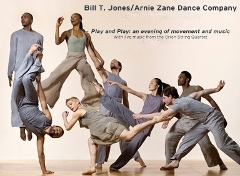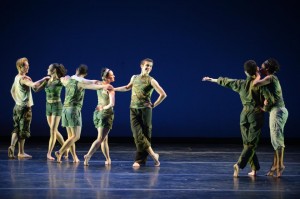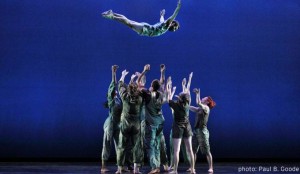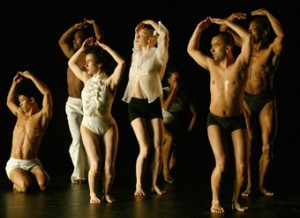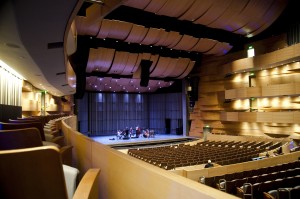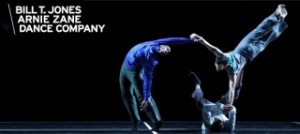JONESING FOR SOMETHING MORE
It’s been 31 years since the creation of the Bill T. Jones/Arnie Zane Dance Company, but since Zane’s death from AIDS in 1988, Jones’”his work and life partner’”has remained the sole artistic director. A touring 30th anniversary season includes two mixed programs, both of which are under the banner of “Play and Play: An Evening of Movement and Music.” One of them includes newer works with Jones himself on stage (reading text more than moving). It is the other bill of older works with no Jones which arrived at the sparsely attended Valley Performing Arts Center last Saturday.
Along with Zane, Jones’”who is black, HIV-positive and gay’”truly broke ground by amassing multicultural dancers with a plethora of body types. Much of his work continues to be based on “contact improvisation,” a partnering dance technique that enables people of different heights, weights and strengths to interact, which is exactly what was seen at VPAC. His distinctive and sometimes militant modern dance is inspired by race, sexuality, counterculture movements and avant-gardism’”as such, his work can be head-scratchingly inaccessible or irresistible; both results were also on display in this program. More recently, Jones has also worked as an opera and theater choreographer, winning Tony awards for Spring Awakening (2007) and Fela! (2009).
It may be telling that only about 350 patrons showed up to VPAC’s 1,700-seat house. With a huge array of pieces under his belt, it’s tough to create buzz when we get three of them which have already been done (1989 to 2000). Los Angeles is craving new and exciting dance, so why do we get a “best of” retrospective? This isn’t to say that Jones’s other mixed program is better (I have yet to see it), but having this charismatic performer and speaker’s commanding onstage presence would certainly have sold more tickets. Then again, sad to say, had the poster for this event proclaimed in all caps, INCLUDES FULL NUDITY, I daresay that also may have helped ticket sales.
The most exciting aspect is the live music (half of the “Play” in “Play and Play”). All of the pieces have classical scores (though sometimes tweaked) played by the notable Orion String Quartet with guest musicians, since two pieces require octets. The players executed works of the masters with an appealing proficiency, and VPAC’s acoustics are stunning.
The program’s credit page quotes the painter Jasper Johns: “’¦take something and do something to it, and then do something else to it’¦” Considering that two of the evening’s works are revisions, that is exactly what the company is up to. But does doing something to something make it better or more relevant? That would be two “no’s” and a “yes.”
No matter the evolution of these works, all three have a prevailing sameness; is it too much to ask for variety? In addition, the first two pieces on the bill have not only declined in effectiveness since first seen, they are tedious and enervating. Despite some of Jones’s trademark kinetic delights, it is clear that only he and his dancers know what these nonplussing works are about, if they’re about anything at all. I was hoping for something more from this company than pretentious dance for dancers’ sake (I espied some members of LA Dance Project in the house). These short pieces say more about physical maneuvering and striking an attitude than anything about the possibilities of Dance Theater.
The 10-minute “Spent Days Out Yonder” (2000) is the most elusive and abstract of the offerings. Dressed in Liz Prince’s blowsy subdued fabrics (Prince designed all the costumes), the attitudinized dancers execute Mr. Jones’s forgettable choreography, which is intentionally loose and sloppy like puppets with slacked strings. This is where many dancemakers go wrong: They focus on one idea and run with it (or in this case, walk), but no variety follows. The use of the andante movement of Mozart’s String Quartet No. 23 in F Major is without definite or serious intention and the ending is elongated while the listless dancers exit.
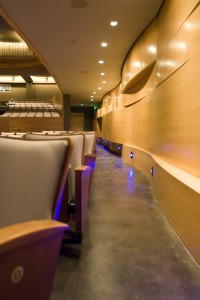 “Continuous Replay” premiered as a solo effort (“Hand Dance”) by Zane in 1977. But this 1991 revision shows none of Zane’s interests in photography and film except as a possible motion study or an edited soundtrack, which includes a crowing rooster, a man in distress, weird dialogue, and numbers counted off as if from mission control. Jerome Begin’s composition, “Music for Octet”’”which is assembled from two Beethoven string quartets: Op. 18, No. 1, and Op. 135’”begins as Redhead Jenna Riegel enters naked. She does a move that resembles “I’m a Little Teapot,” followed by aggressive scissoring gesticulations in front of her face, and lunging. Then she’s off. Then she returns, and one-by-one other naked dancers emerge, accumulating as they mimic her moves while some make a foul hissing sound. Some soloists occasionally burst into bright rectangular light (all three works illuminated by Robert Wierzel), but eventually the dancers begin to wear black and then white undergarments. Because there is no emotion and no communication, the piece ends up as posturing on parade. Since Riegel is the only dancer who remains naked, I can assume it’s some kind of statement about freedom. What does make sense is that this equally pretentious work, according to press notes, “is based on 45 precise gestures accumulated in space and time.” Gesturing does not a great dance make.
“Continuous Replay” premiered as a solo effort (“Hand Dance”) by Zane in 1977. But this 1991 revision shows none of Zane’s interests in photography and film except as a possible motion study or an edited soundtrack, which includes a crowing rooster, a man in distress, weird dialogue, and numbers counted off as if from mission control. Jerome Begin’s composition, “Music for Octet”’”which is assembled from two Beethoven string quartets: Op. 18, No. 1, and Op. 135’”begins as Redhead Jenna Riegel enters naked. She does a move that resembles “I’m a Little Teapot,” followed by aggressive scissoring gesticulations in front of her face, and lunging. Then she’s off. Then she returns, and one-by-one other naked dancers emerge, accumulating as they mimic her moves while some make a foul hissing sound. Some soloists occasionally burst into bright rectangular light (all three works illuminated by Robert Wierzel), but eventually the dancers begin to wear black and then white undergarments. Because there is no emotion and no communication, the piece ends up as posturing on parade. Since Riegel is the only dancer who remains naked, I can assume it’s some kind of statement about freedom. What does make sense is that this equally pretentious work, according to press notes, “is based on 45 precise gestures accumulated in space and time.” Gesturing does not a great dance make.
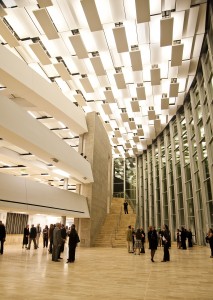 Set to Mendelssohn’s sparkly Octet in E-flat Major for Strings, Op. 20, “D-Man in the Waters” (1989, revised 1998, reconstructed in 2011) remains a thrilling ride. D-Man was created as a tribute to Demian Acquavella, the Jones/Zane dancer who succumbed to AIDS. Instead of an elegiac work, Jones celebrates community by having his dancers catch, hold, and release each other with a frantic free-for-all that drenched the stage in whimsy. For me, the dance is about trust and letting go as the dancers twirl, fish-dive, gallop, jump, and interact in an explosive riot of joy. In fact, a line by Jenny Holzer is in the program notes: “In a dream you saw a way to survive and you were full of joy.” At times in the middle, we sense a suggestion of suffering, but even as the full company of nine wears plain combat-fatigues to reference the war on AIDS, there is nothing bellicose about the work. I can’t help but notice we see some of the precise gesticulations from earlier (the aggressive scissoring), and that the music doesn’t always match the choreography, but there’s enough to justify why this is one of Jones’s most enduring works.
Set to Mendelssohn’s sparkly Octet in E-flat Major for Strings, Op. 20, “D-Man in the Waters” (1989, revised 1998, reconstructed in 2011) remains a thrilling ride. D-Man was created as a tribute to Demian Acquavella, the Jones/Zane dancer who succumbed to AIDS. Instead of an elegiac work, Jones celebrates community by having his dancers catch, hold, and release each other with a frantic free-for-all that drenched the stage in whimsy. For me, the dance is about trust and letting go as the dancers twirl, fish-dive, gallop, jump, and interact in an explosive riot of joy. In fact, a line by Jenny Holzer is in the program notes: “In a dream you saw a way to survive and you were full of joy.” At times in the middle, we sense a suggestion of suffering, but even as the full company of nine wears plain combat-fatigues to reference the war on AIDS, there is nothing bellicose about the work. I can’t help but notice we see some of the precise gesticulations from earlier (the aggressive scissoring), and that the music doesn’t always match the choreography, but there’s enough to justify why this is one of Jones’s most enduring works.
I get a little pugnacious when I think that my drive to VPAC is almost as long as the program, which runs about 65 minutes total. 65 minutes?! That’s a fairly overwhelming trip for such an underwhelming show. Now that the Valley Performing Arts Center is establishing itself as a premier venue for Los Angeles, hopefully they will begin to attract more exciting companies such as Paul Taylor, Hubbard Street Dance Chicago, Joffrey, and Mark Morris. I feel bad about the tepid attendance, but lightweight shows such as Play and Play will one day be seen as a template for what not to book. This acoustically-rich hall is simply too gorgeous and too classy to host anything but the best.
photos of previous productions by Peter Smith and Paul B. Goode
building photos courtesy of the Valley Performing Arts Center
Play and Play: An Evening of Movement and Music
Bill T. Jones/Arnie Zane Dance Company
Valley Performing Arts Center in Northridge
played on February 1, 2014
for future VPAC events, call (818) 677-3000 or visit VPAC
